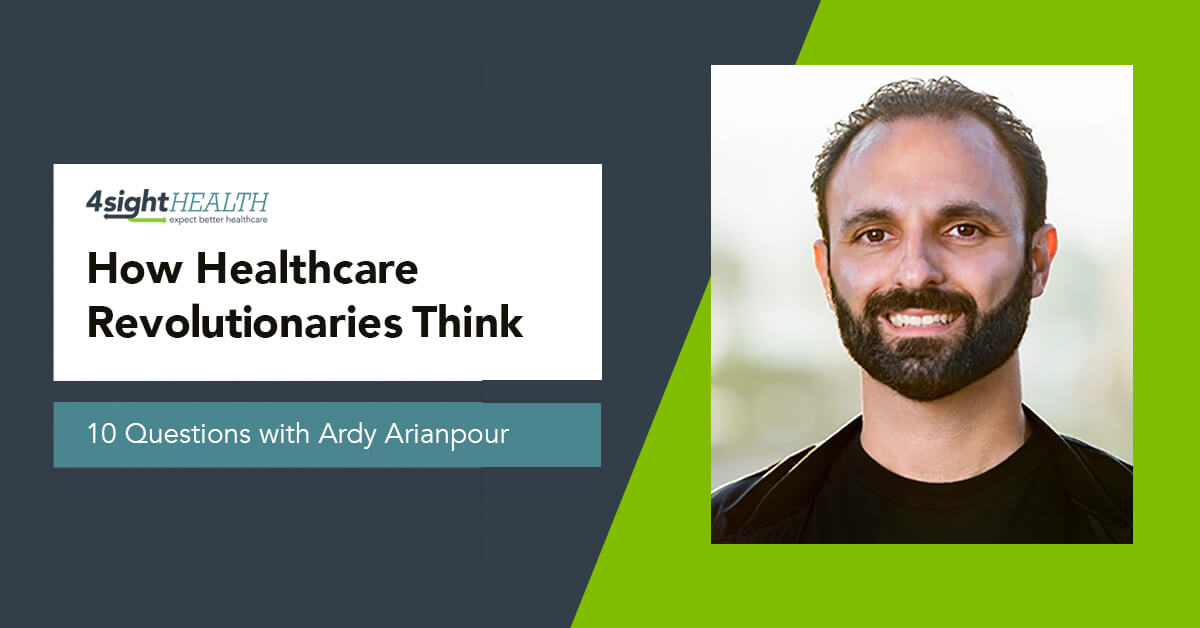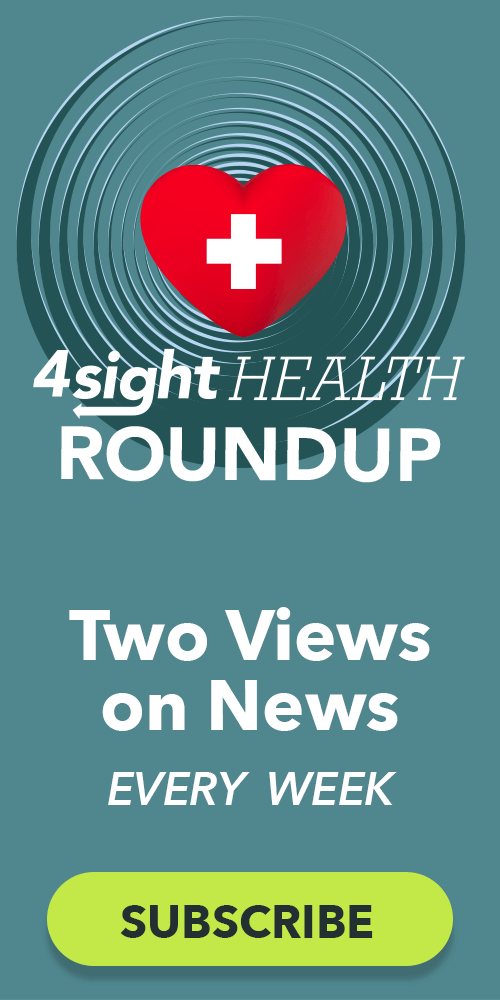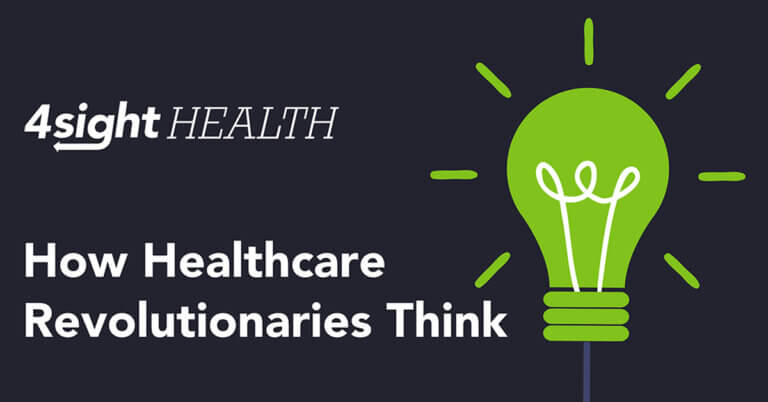July 22, 2025

How Healthcare Revolutionaries Think: 10 Questions With Ardy Arianpour
Welcome to the latest installment of 4sight Health’s series, How Healthcare Revolutionaries Think. Our interview series profiles healthcare instigators who believe that outcomes matter, customers count and value rules.
If you’re into do-it-yourself home-improvement projects, this profile of SEQSTER and its CEO and Co-Founder Ardy Arianpour will resonate with you. Speaking for myself, any DIY home-improvement or fix-it project requires a minimum of three trips to different hardware stores. I never have all the pieces I need in one place to do the job.
It’s like your protected health information (PHI). Your PHI is all over the place in different formats and in different IT systems. It’s never all in one place at the same time to do the job of keeping you healthy or helping you and/or your healthcare provider when you’re sick or injured.
Arianpour and his San Diego-based tech company SEQSTER are out to change that. They’ve built a data platform that retrieves all your PHI from any source, standardizes it and makes your continually updated longitudinal and comprehensive PHI file available with your permission to anyone who needs it. Anyone includes providers, life sciences companies, pharmacies and payers.
I spoke with Arianpour about how he made healthcare data interoperability his raison d’être and why he thinks DNA sequencing and genetic testing results should be a part of a person’s permanent PHI record.
You can also listen to my podcast interview with Arianpour about his thinking on precision medicine and how the current political dynamics in Washington, D.C., is affecting SEQSTER’s business model.
1. Ardy, let’s start with the question we ask everyone for this series, and that’s for your definition of a healthcare revolutionary. What is it?
Arianpour: A healthcare revolutionary to me is someone who doesn’t just make healthcare better. They reimagine it entirely. They take something complex, outdated, impersonal and replace it with something simple, intuitive and deeply human. They use technology not as a crutch but as a canvas to create health experiences that feel magical. And these people don’t wait for permission. They disrupt broken systems to give people their lives back. That’s what it means to be truly revolutionary.
2. Better to ask for forgiveness than for permission, right? Do you have someone in mind who’s done that? A favorite healthcare revolutionary past or present?
Arianpour: One person who comes to mind immediately is Eric Topol, M.D. I started going to Dr. Topol’s future of genomic medicine conference when he started it years ago. This was about 15 years ago when I was deep in the genomic space. He brought the best of the best to the conference. He’s a physician by training. He’s written some amazing books. He’s done a lot of research.
Dr. Topol also was the first patient, first innovator, first skeptic to tweet all his health information using SEQSTER, which connected all his personal medical data from 1985 to the present. His Fitbit at the time. His 23andMe data. His MyFitnessPal app. We were putting together wearables, genomic data and his emergency medical record (EMR) data all from four different electronic health record (EHR) systems. That was a watershed moment not just for interoperability but for the industry. It was the moment that I decided that I wanted to become a healthcare revolutionary. I saw someone bigger than life actually use our technology and tweet about it. We got seven million hits on our website. We had to shut our website down at the time when we were direct-to-consumer.
3. You referred to yourself as a healthcare revolutionary. Why do you fit your own definition?
Arianpour: It was more by accident than by design even though it was my goal. I’ve been fortunate to be at the right place at the right time many times during my 20-plus-year career journey in life sciences and healthcare. Without SEQSTER, I wouldn’t even be talking to you, right? It’s only because we’ve built this incredible technology that puts patients at the center of their healthcare by disrupting all their episodic data, connecting it to their genetic data, connecting it to their remote patient monitoring data, to build a longitudinal health record. We pioneered the longitudinal health record. We cured the biggest chronic disease underlying the entire healthcare system — the lack of interoperability. Now that data is driving the most important application in the world — AI. It really just fell into place.
4. Let’s pick up on interoperability. When did you realize healthcare had an interoperability problem? Was it a personal experience? Business experience? When was your first brush with interoperability?
Arianpour: It actually started during my DNA sequencing days. It’s a different lens than anyone else on interoperability. That’s why we named the company SEQSTER. Everyone is “seeking” health data. When I was building and running a clinical diagnostic laboratory that was trying to bring genetic testing data to the masses, most sequencers at the time — the machines that sequence your DNA — spit out your ATCG. Your ATCG are four base pairs of chemicals in your DNA. All sequencers were interoperable. The vendor didn’t matter.
That’s when we realized that we couldn’t send that data, regardless of the sequencer, to any EMR, regardless of vendor. None accepted the data. Your genome sequencing data was not part of your medical record. We thought, “Wow, if ATCG is interoperable, then hell, all health data should be interoperable. This should be easy.” The problem exists at scale to this day. We didn’t know how hard of a problem this was going to be. We were actually pretty naïve. If we had known how hard this was going to be, we probably wouldn’t have gone down this rabbit hole.
5. Let’s back up. Underneath everything you just said is your belief that a person’s DNA sequence or profile should be part of their medical record, no different from a medical history, latest lab results or medication list. Am I reading you correctly?
Arianpour: 100%. It’s still not. Specialty labs do the work, but those specialty labs don’t connect to or are interoperable with existing EHR systems. How do you get the data in there unless it’s self-reported? Overall, the healthcare system doesn’t fully understand genomics and genetics yet unless it’s a particular hereditary test for something like breast cancer.
But it should be in there. I believe that you should have a 360-degree view of your health. Why would you have a big piece of your results missing from your entire health record? The more information you have, the better decisions you can make. Over time, you can go back and see certain encounters, certain episodes and how they relate to certain events as well. You have to think of it as a puzzle. You want all the pieces, right? You want your MRI results in there. Think of your genome as your MRI for your DNA. It’s pretty essential.
6. I’m sold. Why aren’t hospitals and doctors and other clinicians? Why aren’t they demanding that EHR systems ask for and accept the results of DNA sequencing tests or other genetic tests? Clearly, it’s possible from a technology standpoint.
Arianpour: It has to do with reimbursement. Health insurance companies don’t cover all genetic tests. We have yet to align the incentives. For example, your routine blood work results are in your medical record automatically. They’re reimbursed by insurance. They’re connected to your EMR. If it’s entered there, all you really have to do is hit a few buttons and file a claim for payment. DNA tests aren’t in there because you can’t.
7. We walk a fine line between skepticism and cynicism at 4sight Health. You fit right in with us. It’s technically possible but because you can’t get paid for it, don’t bother adding an interoperable field for it in your EHR. What other barriers have you witnessed to the interoperability of personal health information?
Arianpour: There’s a lot of self-serving bureaucracy in healthcare. If you’re a patient of health system A, why would it make it easy for you to take your own data and share it or move it to health system B? The easiest way to keep a patient, a customer, is silo their data. The patient has to keep coming back to the same place for medical services. That’s where their medical information is even if it doesn’t include their DNA sequence or the results of genetic testing.
8. Have you had your DNA fully sequenced?
 Arianpour: Yes. I was one of the first 50 people in the world to have my DNA and genome sequenced. This was in 2009 when I was running the genomic services division of a clinical diagnostic company. We brought in one of the first genome analyzers. We were the first lab to implement that instrumentation. Some of us were lucky enough to be able to run our genome on that machine environment. Three of us volunteered to go first. We were curious. And, frankly, we knew this would be a story that we could tell for the rest of our lives.
Arianpour: Yes. I was one of the first 50 people in the world to have my DNA and genome sequenced. This was in 2009 when I was running the genomic services division of a clinical diagnostic company. We brought in one of the first genome analyzers. We were the first lab to implement that instrumentation. Some of us were lucky enough to be able to run our genome on that machine environment. Three of us volunteered to go first. We were curious. And, frankly, we knew this would be a story that we could tell for the rest of our lives.
9. How lucky were you? What story did your DNA sequencing results tell you? And do you still have the results?
Arianpour: I do. I have mine on a hard drive. They gave it to us. I have a hard copy of that. And I have the results in the cloud. It’s a lot of data. Even now it’s hard to interpret. But what I found out is I’m not special. There’s a lot of information within your genome. For certain people with markers for cancer or rare diseases, that’s important because if their genes expressed it, it would show up in the results. I was fortunate enough that there was nothing in there. No news is good news, right?
10. You’ve been doing this for almost 10 years now. Most healthcare entrepreneurs and innovators cash out in three or four years after they get the itch to do something new. Why stick around?
Arianpour: The emails and calls from people who say, “Your technology changed my life.” That’s what fuels me. Whether it’s a caregiver navigating a rare disease, a clinical trial participant feeling truly seen or a researcher unlocking new insights with SEQSTER’s data. It’s really changing lives in real time. I see it every day. I’m driven by a sense of responsibility now. We’re not just building a platform. We built it. We built the rails for the future of precision medicine. That’s worth waking up for and sticking around for.
Burda’s Final Brief
I’ve had two surgeries during my 65-year-old life. In 2001, I had my right knee scoped to finally remove some torn cartilage from a high school football injury. (In gym class. I was not on the football team.) In 2005, I had my left Achilles tendon reattached after it snapped playing a pickup game of three-on-three basketball with five people half my age. (Stupid then. Stupid now.)
The only way you would know about the surgeries other than reading this is if you found CDs of images from the procedures that I keep in a kitchen drawer. (Good luck. Let me know if you find the old garlic press.) The images should be in an online file that contains all my protected health information from birth until today that’s accessible to me and any provider who needs to treat me. Childhood immunizations to COVID vaccines to seasonal flu shots to recommended immunizations for seniors. A complete and up-to-date medical history. Past and current medications. Health-related social needs. DNA testing results.
We’re all so tired of filling out paper or electronic forms asking for the same information over and over again. SEQSTER’s technology can end the madness by gathering our PHI in one place. Expanded access, lower costs and better outcomes would be the results. Such technology can be a mighty tool in support of the customer revolution in healthcare. Let’s start plugging it in.
Ardy Arianpour is a visionary health tech executive with 20+ years driving innovation in life sciences and digital health. He is CEO and co-Founder of SEQSTER, the leading healthcare technology company that puts the patient at the center of all their health data. SEQSTER was founded with the mission of positively impacting patient lives at scale by removing the barriers to health data access. For the first time, users create their own matched, longitudinal health data profile across all of their U.S.-based healthcare data sources through person-centric interoperability.
SEQSTER offers tokenized, comprehensive patient data. Efficiently captured and exportable at scale. Learn more.
Read more interviews with healthcare revolutionaries
HHealthcare Revolutionary Perfecto Sanchez
Healthcare Revolutionary Kemena Brooks
Healthcare Revolutionary Katie Kaney
Healthcare Revolutionary Hal Andrews
Healthcare Revolutionary Julie Murchinson
Healthcare Revolutionary David Terry
Healthcare Revolutionary Matt Marek
Healthcare Revolutionary Mark Engelen
Healthcare Revolutionary Chris Johnson
Healthcare Revolutionary Ramona Wallace, D.O.
Healthcare Revolutionary Alejandro Quiroga, M.D.
Healthcare Revolutionary Samir Goel
Healthcare Revolutionary Marcus Whitney
Healthcare Revolutionary Demi Radeva
Healthcare Revolutionary Michael Pitt, M.D.
Healthcare Revolutionary Rebeckah Orton
Healthcare Revolutionary Dan Trigub
Healthcare Revolutionary Bruce Brandes
Healthcare Revolutionary Lena Chaihorsky
Healthcare Revolutionary David Nash, M.D.
Healthcare Revolutionary Esther Dyson
Healthcare Revolutionary Meghan Conroy
See if your favorites are included in the series and let 4sight Health’s David Burda know who you consider to be a Healthcare Revolutionary.





